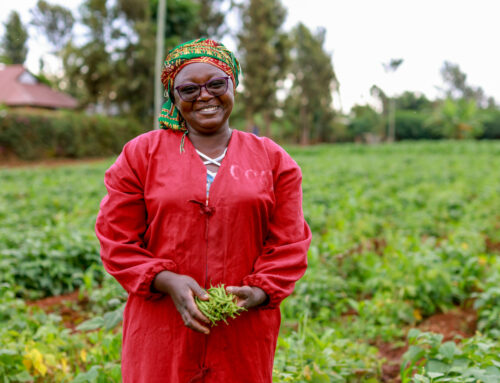Key ways to reduce food losses at farm level
Fernando Cojulun is InspiraFarms’ Head of Technical Services, and has over 10 years of experience in Latin America, Africa, and the United States working with large-scale rural development programs. Many of those programs focus on connecting smallholder farmers and small and growing agribusinesses with global food supply chains.
#1 – Improved storage and preservation methods – cold storage can drastically cut food losses, especially for small-scale farmers in the developing world. Such farmers frequently lose food to factors like pests, spoilage, and transportation damage. Having cold rooms with adequate ventilation, and controlled temperature, humidity, ethylene (for climacteric fruits) and air circulation levels helps producers maintain the quality with and shelf-life of produce. This is key when selling into high-value markets, whether domestic or export.
To maximize the effect of cooling and reduce risks to shelf life, fresh produce should be brought to the optimum temperature as quickly as possible after harvest. Pre-cooling reduces the field heat, which is detrimental to the quality of fruits and vegetables, and slows ripening. Pre-cooling can be done a number of ways, such as shades, forced air cooling, hydro-cooling. Prompt pre-cooling conserves the weight and extends the storage life of fruits and vegetables. It must be must be combined with a cold chain, meaning the produce is transferred to storage at the optimum temperature directly after pre-cooling.
Handling methods are also important. For example, using plastic crates instead of plastic sacks during transport can cut loss dramatically by preventing bruising and squashing of produce.
#2 – Storage techniques – It’s important to have key information on solutions and techniques for storing and transforming. For instance, certain types of produce cannot be stored together because they require different temperature and humidity levels. Additionally, crops that produce high levels of ethylene, such as apples, need to be separated from produce that is sensitive to the naturally occurring gas—this includes lettuce, cucumbers, carrots, potatoes, and sweet potatoes. Storing such produce with ethylene-producing crops is likely to result in damage and spoilage of the sensitive produce.
Pre-cooling can be optimized by stacking produce in well-ventilated pallets in the shade, allowing to remove field heat and facilitating higher respiration rates from crops before storage, which means increasing oxygen and facilitating the exit of carbon dioxide, for decelerating the ripening process which can lead to spoilage. Shade is a natural ally in the fight against food loss, and farmers and agribusiness can optimize temperature ranges of storage and processing facilities by constructing them in shaded areas and by painting them white to reflect the sun’s radiation. This will help businesses save money on their energy costs. FAO has a useful database of recommended storage temperatures.
#3 -Transform and add value – Rapid on-farm and near-farm processing can be a way to ensure end-market for produce, while also reducing post-harvest losses at points of storage and processing. Processing with cold storage can improve the shelf life of highly perishable crops. It can also allow producers to capture better prices and margins, as they add value—for example, via washing, trimming, peeling, and packing—to raw materials. Mobile or pre-fabricated processing units represent a fast and affordable solution for installing processing and storage capacity at farm level. Additionally, introducing drying techniques at the farm level can reduce fresh fruit losses while also creating a value-added product with much higher durability and shelf-life. Depending on the crop, on-farm processing and selling to constant buyers have the potential to reduce post-harvest losses by as much as 80%[1].
#4 – Food safety compliance – Food safety assurance programs-including the Good Agricultural Practices (GAP), Good Manufacturing Practices (GMP) and Good Hygienic Practices and Hazard Analysis and Critical Control Point system (HACCP)—provide control protocols that prevent product contamination from bacteria and fungi. These protocols also control the presence of field residues—such as stones and even metals—through production to packing and shipping.
Complying with these certifications considerably reduces the risks of rejection, which translates into less food waste. Complying with food safety certifications can also help fetch a higher price per kilogram for producers, with premiums ranging in some cases from 5-10%. Quality assurance ensures longer, more profitable client relationships and higher opportunities for accessing high-value markets.
#5 – Collaboration and coordination – Often, rejections at pack-houses are a result of products not meeting customer specifications for sale. Farmers and small and growing agribusinesses can reduce these types of rejections by working closely and in collaboration with value-chain members—such as importers, packaging companies, food companies and supermarkets–to identify the major causes
#6 – Sell local – Where available, small farmers and agribusiness can identify “secondary” local markets for selling the produce that was rejected, but in good conditions for being traded and consumed. Alternatives can be local retails markets, supermarkets, restaurants and hotels. By offering deals, such discounted prices and offering delivery services can be a way of attracting customers and securing some income.
To know more you can reach Fernando at fcojulun@epven.com
[1] Deloitte, 2015. Reducing Food Loss Along African Agricultural Value Chains. www2.deloitte.com/content/dam/Deloitte/za/Documents/consumer-business/ZA_FL1_ReducingFoodLossAlongAfricanAgriculturalValueChains.pdf



